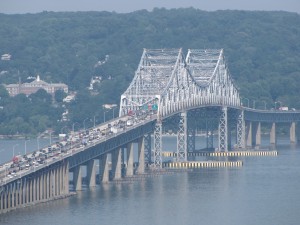Private profits, public risks
Hobbled by a $10 billion budget deficit and shadowed by a looming infrastructure crisis that will cost an estimated $250 billion to avert over the next two decades, New York state could turn to the private sector to finance, build and operate public facilities.

In Westchester County, business and government leaders this year will explore variations of a public-private partnership as the vehicle to drive forward the Tappan Zee Bridge replacement project, whose estimated $16 billion price is a major obstacle to construction.
Against that background, state Comptroller Thomas P. DiNapoli this month issued a report alerting policymakers to primary financial risks associated with public-private partnership models applied in other states and countries.
The state should proceed with caution, he warned, and only after comprehensive infrastructure planning and capital spending reforms.
DiNapoli, the former state assemblyman from Long Island, in his four years in the Albany office often has assailed the state Legislature for its habitual use of one such risky practice: “budget gimmickry.”
Public-private partnership agreements “are sometimes used for short-term fiscal relief, which provides a short-term cash benefit while pushing costs to the future and potentially increasing debt,” he said in the report.
That short-term relief was pursued by both the city of Chicago and the state of Indiana, DiNapoli claimed, when they signed separate long-term leases with a Spanish-Australian joint-venture consortium, Cintra-Macquarie, to operate the 7.8-mile Chicago Skyway toll bridge and highway and the 157-mile Indiana Toll Road.
Cintra-Macquarie in 2004 agreed to pay Chicago $1.82 billion ”“ 36 percent of the city”™s budget ”“ for operating and revenue rights to the Skyway. The private partners in 2006 paid Indiana $3.85 billion to operate and collect tolls on the major interstate link between the Midwest and East Coast.
The privatization deals reaped immediate benefits for both Chicago and Indiana, according to a 2007 study report co-authored by academics at the Indiana University of School of Public and Environmental Affairs. Credit rating agencies upgraded bond ratings for both the city and its neighboring state in the wake of the agreements with Cintra-Macquarie, they said, which should result in lower borrowing costs for both governments.
The $3.85 billion infusion to Indiana”™s budget has been used by the state transportation department to proceed with road and infrastructure projects that had languished, said Cameron Carter, vice president of the Indiana Chamber of Commerce in Indianapolis. “That”™s not to say it”™s been a panacea for all of the state”™s infrastructure needs,” he said. Indiana has joined neighboring Kentucky and Ohio in forming a tristate commission that is exploring the public-private partnership option for bridge construction projects, he said.
Carter said the Indiana chamber and other business groups are lobbying this year for a blanket public-private partnership law that would authorize the governor and transportation officials to execute agreements with private partners for needed infrastructure projects without first going to legislators for approvals.
For the state”™s Indiana Toll Road operator, which expects a 15-year payback on its investment, the asset may prove more valuable in the long term than was originally forecast, according to the Indian University study. Greater profits than expected may raise public concerns, the authors said. A profit-sharing agreement between the public and private partners “could result in better public sector value over time,” they wrote.
DiNapoli in his report warned of the same risk to New York taxpayers from undervalued assets. “This danger is acute because public entities are often persuaded to sign leases for very long periods, such as 99 years, even though it is inherently difficult to ascertain the value of major infrastructure assets in the long run,” he said.
Toll rate increases by private operators could drive some New Yorkers to alternate roads, DiNapoli said, adding to local traffic congestion and raising road repair and construction costs and debt burdens for the state and municipalities.
Applying the maximum annual toll increases guaranteed the Cintra-Macquarie partners in their Chicago and Indiana contracts, DiNapoli said tolls on a privatized Thruway would have increased 2,514 percent from its opening in 1954 through 2009. That is nearly 10 times the actual 254 percent increase in Thruway fares over that 55-year period.
“Protecting the public from these financial risks may mean limiting private sector profits,” DiNapoli said. Yet restrictions on profits could deter potential private-sector partners from investing in public projects, he said.
“Public-private partnerships may provide a new and useful option for the financing and construction of public infrastructure in New York state,” the comptroller concluded, “but they also present some of the most complicated and challenging financial arrangements that the state has ever considered.”